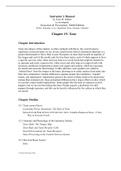Class notes
Study Guide Instructors Manual Sensation and Perception
Sensation and Perception is a compelling introduction to the key topics in the field, exploring fundamental questions about the human senses. Students will become acquainted with their own senses, examining human sensory and perceptual experience and the neuroscientific underpinnings of that experi...
[Show more]




